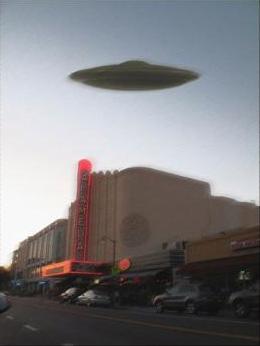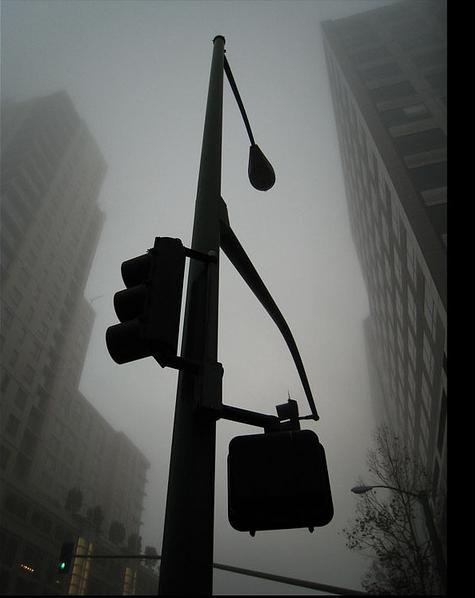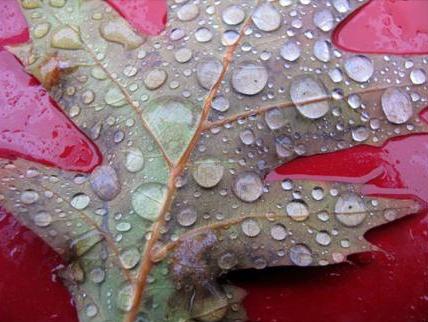UFOs in Alameda?
April 7th, 2011
Carl Weingarten, Unidentified Matinee, 2009.
Carl Weingarten is best known — and well known — as a music producer and guitarist, but he’s also a lifelong photographer. His “Photographic Impressions” at Blue Dot Cafe & Coffee Bar showcases a cross-section of his recent work, including classic black-and-white landscapes, imaginative photo-collages, and a few historic images which he has restored. It is his second exhibit at this venue.
Weingarten started shooting with a kit camera as a child before moving on to cinematography and, finally, music. “But there’s no love like the first love,” he wrote in his statement. “Through it all, my still camera was never far away, and I have documented many adventures over the years. Then came digital photography, and it was like getting my first camera all over again.”
He uses the digital medium to great effect in the playful digital collages “Unidentified Matinee” and “River Street.” The former piece shows a UFO hovering over the Alameda Theatre & Cineplex.
“The theater has a gothic, other-time feel to it. Even aliens would come to observe and rendezvous,” Weingarten conjectured. “What better place to hover a UFO over than a gothic movie theater?
“I was going for an Instamatic kind of look to it,” he added. “The original was shot on digital. The colors were pretty muted. And at the time I just wanted to capture a picture of the theater that was okay.”
He then painstakingly integrated an image of a flying saucer licensed from a Canadian CGI designer. “It only works if to the eye it has some type of plausibility to it. If you just paste it in there it wouldn’t work at all,” he said. “I spent a lot of time trying to match the lighting and color. I tried to give it a film grain look and the camera a little shaky look, an amateur catching (the image) kind of thing. I like to put that kind of realism in the photos.”

Carl Weingarten , The Guardian (1), 2010.
Some of Weingarten’s most outstanding work has had no digital manipulation at all. “The Guardian [1]” (and especially “The Guardian [2],” not on exhibit) has an almost Kandinsky-like geometry and calls to mind Michael Kenna’s masterful 1976 “Flatiron Building, Study 1, New York City, USA” with its play on the perspective between skyscrapers in the background and traffic light pole in the foreground.
“There’s no special effects,” he said. “It was really a matter of getting the right angle. It was in Oakland where I work on occasion and it does get foggy here, not unlike SF. There’s a scene in this Fellini film (“Amarcord”) where objects are sort of emerging from the whiteness and everything has this ethereal and spiritual kind of quality to it. It was a foggy morning and there was just enough thickness in the air and it just struck me that the light poles were figurative. They were like hands reaching.”
Others photos are more simple, and simply beautiful. “After the Fall” plays on Adam and Eve’s fall from grace on several levels, but with its heavily saturated colors, layers of textures, and careful composition, it is first and foremost aesthetically pleasing.

Carl Weingarten, After the Fall, 2010.
Rounding out the exhibit are historical images Weingarten acquired from the Library of Congress and lovingly restored, including the Wright brothers on a beach “holding up the only truly functional flying machine in the world, like a kite.”
“Since I was a kid there’ve been certain historical events that have always fascinated me for whatever reason: the Wright brothers, ships, and shipwrecks,” he explained. “The rarity of the image made them even more compelling. Something like the Titanic, there’s really not a lot of material. It only took one voyage. So you treasure whatever’s there.
“With the Wright brothers I’m just fascinated with the fact that these guys and their friends were doing things just because they felt like it, and they were alone in the world, doing something that would have a huge impact on humankind.”
Although the work on display runs the gamut, the pieces are tied together by Weingarten’s artistic vision.
“Some common threads run through my music and photography and film work. I would call it ‘cinematic.’ The music I do tends to be atmospheric and evocative of a scene in a film, suggesting drama and characters,” he said. “In my photos there’s often a sense of motion and movement. Not necessarily that something is in motion and I’m following it; but there’s a story in there. There’s a scenario. There’s a movement in a scene.”
Weingarten’s photos are printed as posters such as those sold in museum gift shops, including large captions at the bottom. Accordingly, they are offered at a mere $90 each, or $45 unframed. The artist calls these “recession prices.”
“Photographic Impressions” runs through April 15. Blue Dot Cafe & Coffee Bar is located at 1910 Encinal Avenue. Their hours are 7:30 a.m. to 5 p.m. Monday through Friday, 8 a.m. to 4 p.m. Saturday and 8 a.m. to 2 p.m. Sunday.
Michael Singman-Aste
Postdiluvian Photo
Tags: Alameda, Carl Weingarten, Kandinsky, Michael Kenna, The Island



Leave a Reply
You must be logged in to post a comment.